Convert OST in PST: Easy and Secure OST to PST Conversion Too
In this blog, we are going to discuss 4 effective methods to convert OST in PST with or without Outlook. Simply read the complete write-up and follow instructions. You can access exported PST in any version of Microsoft Outlook.
For quick and secure export process, use should use professional utility. Choose your OS and download the utility and easily export all data from OST in PST file.
OST file aka Offline Storage Table is a file created by IMAP Server (Exchange Server) automatically while configuring IMAP profile (Email ID) into Outlook. The OST file is replica of Microsoft Exchange server mailbox and allows users to access it even without internet connection.
Sometimes when the user creates an account with IMAP configuration, then it also works as a web server-based application and stores synchronizing data in (.ost) file.
However, there are various situations when these files become inaccessible. To manage the situation, the user needs to change the OST file into another file format i.e. PST file. So that data can easily be accessed in offline mode. In the below section, I am explaining 4 methods that can be followed by users to convert OST in PST file.
Why Convert OST in PST File Format?
There are multiple reasons that can force user’s to export data from OST file to PST. Some of them are listed below. User can scroll below to know the steps.
- Power Failure, Malicious Software, and Virus Attacks can hamper Exchange server mail flow and it results in email breakdown.
- Email Migration: Changing email server or mail client for any reason.
- Free Space from Exchange Database: Exchange admin needs to manage storage space. The simplest way to take backup of OST file into PST format and delete data from server.
- Employee Left the Organization: When ever employee left the organization, the Exchange Admin has to backup his mailbox and delete from server.
- Open Orphaned OST File: Microsoft does not provide any way to relink or open orphaned OST file even with Outlook. In this case, first export OST in PST format and then access it in Microsoft Outlook.
What is the Difference between OST and PST files?
Below the direct comparison between OST and PST files is as follows, this will give a better understanding as to why convert OST in PST is too important.
- OST files keep synchronizing the changes with the email server provided you are connected to the internet but PST does not let you do so- PST enables you only to work with it in MS Outlook only when you have an internet connection.
- Sup only with Microsoft Exchange Server, but OST files are compatible with other services such as Microsoft Exchange client and Microsoft Outlook for PST files.
- From the Microsoft Outlook 2016 onwards, the client saves all messages and appointments from IMAP and MAPI accounts together in an offline storage table (OST) file, while, in Outlook 2013 or later, the messages from IMAP and/or MAPI accounts can by stored in the PST file.
- Even if in the OST you experienced minor corruption or any problem in accessing it, you can just make use of the ScanOST. exe tool. However, if the PST file is corrupt or damaged, there is an onus of scanning known as the ScanPST in the office 365 environment. exe tool that, enables the users to repair all the Outlook PST file problems.
Methods to Convert OST in PST File
Now, let us list the different solution to export data from OST file to PST . All the mentioned steps are secure and widely used. Use can rely on them, let us list the methods.
- Using the Auto Archive Setting
- PowerShell Script for OST in PST Conversion
- Free Convert OST in PST with Outlook Manually
- Convert Orphaned OST in PST Free
- Expert Suggested Way to Convert OST Files to PST
Both solutions have advantages and disadvantages. In cases of orphaned OST, inaccessible OST, corrupted OST, Exchange Downtime, and so on, I recommend that users use third-party software. But, If you can access your IMAP profile through Outlook. Then, using Outlook’s Import/Export feature, follow steps in method 2.
Method 1: Export OST in PST Using the Auto Archive Setting
Auto Archive is one of the features provided in Microsoft Outlook that is used to resolve the problem of occupying much space in ones Mailbox by automatically archiving old items. This feature can also be used other activities such as archiving of the data to Convert OST in PST files.
- Power on the computer containing Microsoft Outlook on it.
- Initially, go to the File menu located in the top-left corner of the program window.
- Go down the displayed menu to the File tab, which is located at the top of the NetBeans IDE window.
- Scrolling down would make you expand this area of the window where you want to make changes, and the following would pop-up: This would open the Outlook Options window.
- Select the outlook options tab; under the display group, select Advanced from the list on the left panel.
- Click the AutoArchive button and go to AutoArchive Settings.
- AutoArchive window also has options of how frequently AutoArchive will run and where the items will be archived to.
- Look at the box next to Run AutoArchive every [number] days and enter the number of days that you want AutoArchive to run.
- Also, select/clear the Prompt before AutoArchive runs check box to decide whether to be notified before AutoArchive is performed.
- To set the location for the storage of the PST which you are archiving, click on the Browse button that is located right next to the Move old items to field.
- Select a simpler name that is easy to memorize and easier to get to.
- To use the settings for all of the folders, click on Apply these settings to all folders now button.
- Navigate to your Windows Mail App, right click any folder in the mailbox.
- Select Properties.
- Next after that go to the AutoArchive tab which is available in the Properties window.
- Select Archive items in this folder under the default settings or, if your settings options allow, change the settings especially for this folder.
- After you have completed the setup of the AutoArchive settings you have set and applied, then the AutoArchive window minimizes then the Outlook Options including the Outlook Options window as well.
- To run AutoArchive on the system, they have to click on the File, then Info, then Tools and finally Clean up old items. Select the folders to archive and the date range to include in the archive; click OK.
- Once AutoArchive is executed, any items that have been deemed to be archive worthy will be moved to the identified PST file.
Method-2: Run PowerShell Script to Perform Conversion
If we look at it generally, Microsoft doesn’t provide an option that allows a user to directly convert an OST in PST. This is because the APIs for both Outlook and Exchange Server do not support export operations.
Using the New-MailboxExportRequest command, an Exchange Administrator can export emails from an OST file. To run this command, you need to use the Exchange Management Shell, which is a part of the Exchange Management Tool.
Let’s understand through an example how someone can use PowerShell commands to convert an OST in PST. Before starting, let’s go over the requirements.
Pre-requisites
- Exchange Management Shell: It must be installed and configured on same system.
- Permissions: The user must have the necessary permissions to perform mailbox export operations.
- Shared Folder: The destination folder where the PST file will be saved must be a shared folder that the Exchange server can access.
Steps to Use the Script for OST in PST Conversion
- Open Exchange Management Shell: This is a specialized version of PowerShell for Exchange.
- Run the Script: Copy and paste the script into the shell, then execute it. Change the $mailbox and $exportPath variables as per your system configuration.
Load Exchange Management Shell if not already loaded. Skip this if already loaded.
if ($null -eq (Get-Command Get-Mailbox -ErrorAction SilentlyContinue)) {
Add-PSSnapin Microsoft.Exchange.Management.PowerShell.E2010
}Specify the mailbox and the destination path for the PST file
$mailbox = “user@domain.com”
$exportPath = “\\\\Server\\Exports\\user.pst”Create the export request
New-MailboxExportRequest -Mailbox $mailbox -FilePath $exportPath
Optionally, monitor the export request
Get-MailboxExportRequest -Mailbox $mailbox | Get-MailboxExportRequestStatistics
Check Status of Export Request
Excecated the following command and check the export request status
# Command to List all export requests
Get-MailboxExportRequest
# Get details of a specific export request
Get-MailboxExportRequest -Mailbox user@domain.com | Get-MailboxExportRequestStatistics
Method-3: Free Convert OST in PST Using Outlook
Microsoft Outlook users can easily export data from OST file. Follow below listed steps to use Microsoft Outlook inbuilt Import/Export option.
- Step-1: First, you need to open MS Outlook then, click on “File” and select the option “Import/Export”.
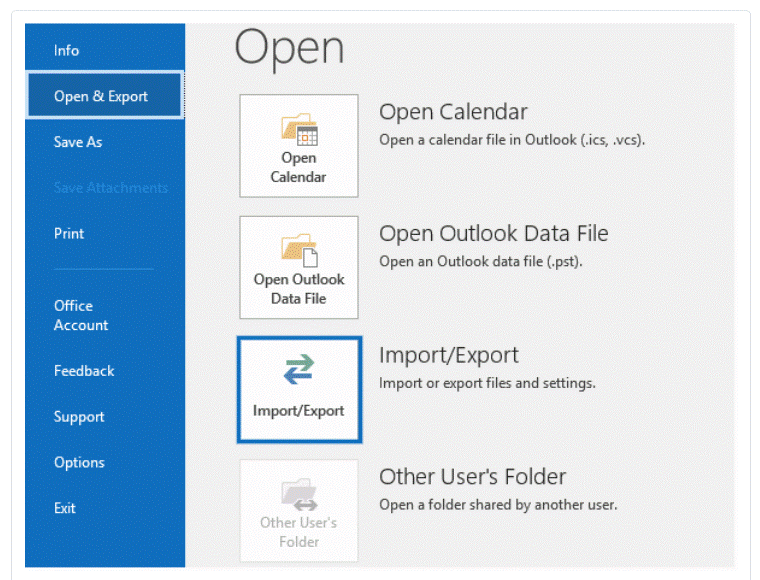
- Step-2: A new dialogue box opens asking to “Choose an action to perform”. Select “Export to a File” and proceed.
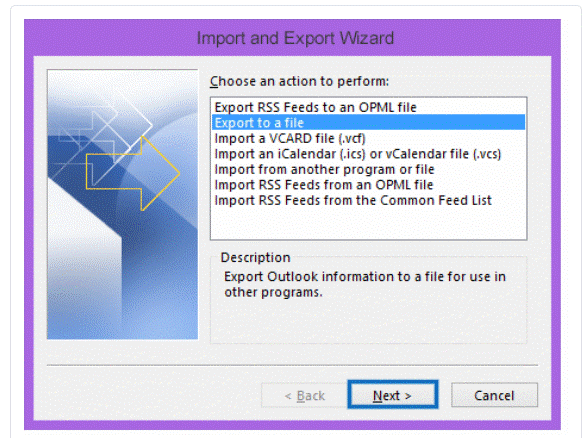
- Step-3: The next screen will ask to choose the file type to import. Choose “Outlook data file (.pst)” then hit the button to “Next”.
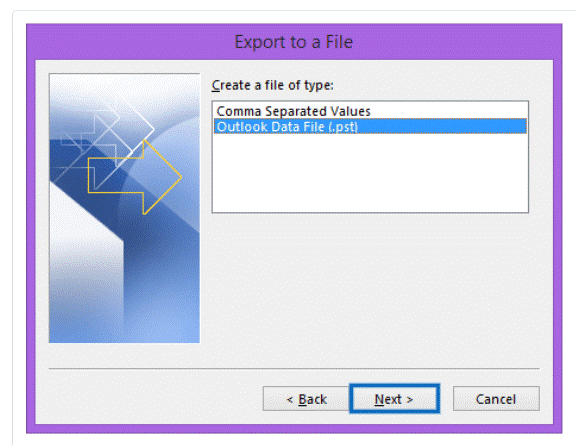
- Step-4: Now, choose the folder to export data from, and click on “Next”.
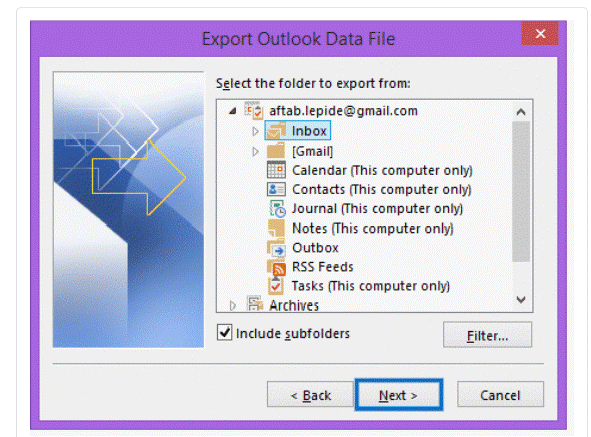
- Step-5: Choose an option from the list “Allow duplicates to be created” and click “Finish”.
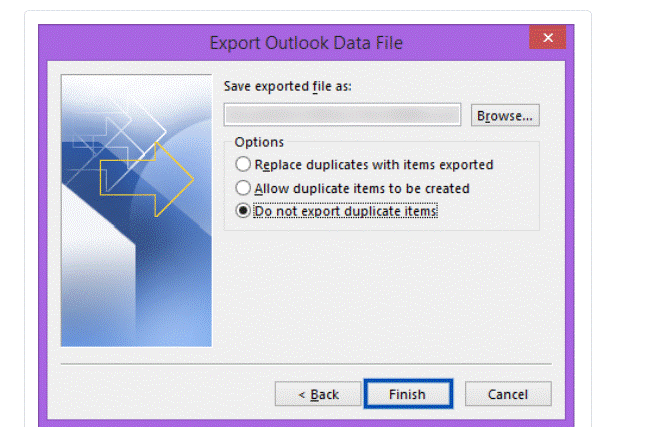
- Step-6: After it, a new pop-up com to ask for an optional password. You can easily move ahead without entering it.
Now, manually converted Microsoft Outlook OST in PST file format. You can check your OST files which have been saved in PST file format at the selected location.
Method-4: Convert OST in PST Free Using Outlook IMAP Account
Most of the free solution fails to export orphaned OST files into PST format. But here in this method I will explain a severely verified and tested method.
Key Points: This method is little bit tricky and requires some technical understanding. So, as per my understanding, if you are not techie and then do not follow this.
- Requirements: Microsoft Outlook with IMAP configured profile
- Time Required: 10 to 16 Min.
Note: If your IMAP profile is configured in Outlook and you can access the same profile. Then follow the steps mentioned in method 1.
Let us start the steps to convert orphaned OST in PST for Free!
- Launch Outlook and locate the storage path using any of the methods listed below.
- Follow the given path (C:\Users\Admin\AppData\Local\Microsoft\Outlook) remember that the path may be slightly differ in different version of Outlook and Windows OS.
- You can also open the storage path from Outlook dashboard, simply right-click on your profile and click on open file location.
- Disable Automatic Send/Receive option of IMAP profile. This profile we will use further to convert OST in PST format.
- Close all instance of Outlook
Now return to the Outlook storage location you selected in step 1. Simply copy the connected outlook profile OST file (support abc.ost) and paste at same location (abc-copy.ost). Now you have two OST file of same profile. Delete your main OST file (abc.ost), and make sure you have backup copy of same mailbox.
- Copy the orphaned OST file (suppose xyz.ost) which you want to convert and paste it to the same location where abc.ost file is saved.
- Now rename your orphaned OST file as your working OST file (For Example: xyz.ost to abc.ost)
- Launch Outlook and select same profile which we used in above scenario (abc.ost).
- Use Import/Export feature inbuilt in Outlook and explained in Method 1. It will provide you a healthy and accessible PST file which is created from orphaned OST file.
- You can perform same steps for multiple OST files. After completion conversion of OST in PST format. Close all instances of Outlook and deleted all OST files except abc-copy.ost, and rename it to abc.ost and enable automatic Send/Receive option and use your existing profile seamlessly.
That’s all to convert OST in PST free even the orphaned OST file.
Limitations of Manual Method to Export Data from OST file to PST :
We have discussed the above manual method to convert OST in PST without Outlook, having some drawbacks, as mentioned below:
- Need to configure Outlook Account in the system.
- The system must be connected to the MS Exchange Server.
- The slow process as compared to manual methods.
- Risk of data loss or corruption.
- Need a technical expert to follow the procedure.
Method-4: Convert OST in PST without Outlook
To overcome the limitations, we are recommended to use an automated tool to convert OST in PST without Outlook.
Offline OST in PST converter is one of the best third-party software which makes this task easy and facilitates a user. It completes the process of conversion in just a few simple steps and is free from risks or error chances.
This software export mailboxes from OST in PST file format. It also allows us to recover, backup ad extract all items of offline OST files.
Also helps to convert IMAP .ost to .pst, with not having any file size limitations. It provides a preview of data like emails, contacts, calendars, or other mailbox items before conversion.
This tool also has the additional ability to save OST files into different file formats like PST, HTML, MSG, EML, MBOX, EMLX, NSF, PDF, vCard, CSV, ICS, TXT, MHT, DOCX, DOC, and RTF. It also provides a demo version for free with limitations to export only the first 25 items per folder. Then, if the user will be satisfied, they can go for a licensed version available at affordable prices.
When to Use Professional Software:
The Outlook Import/Export feature has some limitations. You can use OST in PST converter software to get around them.
- Want to Convert OST file without Outlook
- Same Profile and IMAP Configuration Not Required
- Convert Large Size OST File without Any Limitation
- Want to Convert Orphaned OST File to PST Format
- Export Corrupted, Inaccessible, Offline OST in PST file
Steps to Convert OST in PST without Outlook
Follow these simple steps to convert emails from OST in PST file format without Outlook, with the help of this tool:
Note: – The software is capable to export orphaned, corrupted, inaccessible OST files to PST format even without Exchange profile and server connectivity.
- Step-1: Download OST in PST converter and install the software in your system offline and start the conversion process.
- Step-2: Simply Add Files and preview OST files items into 8 different view modes. After that hit Export button.
- Step-3: To export click on the radio button to PST and proceed.
- Step-4: Browse the destination location to save exported PST in your system. After that hit Export button to start the conversion of OST in PST format.
- Step-5: Ensure the accuracy of the exported data by locating the directory where the PST file has been stored after completing the conversion process.
Now, the procedure has been completed converting OST in PST in just a few steps. You can check your converted PST data at the destination location. Simply launch Outlook and use Import/Export option to access this file in Outlook. Get the complete guide for OST to Outlook import process.
User’s Reviews After Performing Above Steps
Many users tried this converter software and shared their thoughts. I’ve included a few reviews on this page.
By Marc Vidal
Hi all, I came across this page while looking for a solution to convert OST in PST format. I purchased this OST in PST converter and installed it on my Windows 11 system. It worked well in my case.
By Ameliya Lanne
I copied OST file form my old laptop using pen drive and tried to access same in my new laptop Outlook. But it was not that easy, because later on I got know that Outlook allows to import PST only. So, i searched on Internet for solution to convert OST in PST format. This post helped me to understand the conversion process. I recommend everyone to buy this OST in PST converter full version.
By Steph Joria
I followed the steps explained in method 1 to convert OST in PST for free. I successfully exported complete data manually.
By Mattias
This post assisted me in converting OST in PST without Outlook. I had 37 OST files stored on an external hard disc. OST in PST converter software described above made it very easy for me to complete the task.
FAQs Related to Conversion Process of Convert OST to PST
Q: Is It Possible to Access Orphaned OST File?
Answer: Yes, but for this first you have to convert orphaned OST files to PST format.
Q: How Do I Convert OST Files to PST for Free?
Answer: Microsoft Outlook has an inbuilt utility i.e. Import/Export, you can try this and export complete data.
Q: How long does it take to convert OST file?
Answer: There is no fix timing for converting OST in PST format. It depends on size of OST file and system configuration.
Q: Is It Safe to Use Third Party Software for Conversion?
Answer: Yes, third party tool allows you to export complete data on your own system. But remember to use only trusted tools.
Q: What Should I Do If My Exchange Profile Is Deleted?
Answer: In this case, find the respective OST file and convert it into PST format using method 3 and then access output file in Outlook.
Q: Which is Faster and Reliable Way to Change OST File Extension?
Answer: All the solutions explained above are safe to follow and guarantees users for no data loss.
Conclusion
Manual methods are free, but have some limitations. You can free convert OST in PST format manually, if your system is having MS Outlook configured with Exchange Server. Also, These methods usually take longer time.
Using above listed software is a more facilitated then the free methods to convert OST files to PST file format. However, you are free to choose the solution that best matches your need.


